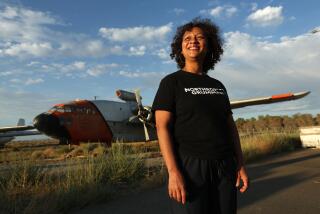Citrus College Celebrates Its 75th Anniversary
- Share via
GLENDORA — Back in 1915, when Azusa was all orange groves and tall rows of stately eucalyptus trees, 27 students walked into a wooden building and formally opened Citrus College, the first community college in Los Angeles County.
The idea of a hometown, tuition-free education was a novel one in those days, and students shared space and 15 faculty members with Citrus Union High School next door.
In fact, it wasn’t until 1919 that residents passed a $300,000 bond issue and bought 17 acres of land in Glendora to build what eventually would become Citrus College.
Today, expanded into a 104-acre campus with 10,000 students, Citrus College is gearing up to celebrate its 75th anniversary.
The fete, slated for Wednesday, will include a concert by the Citrus College Jazz Fusion Ensemble and a balloon launch. Margaret Mary Lindemood, 76, the oldest member of this year’s graduating class, will be honored.
In addition, the anniversary will serve as a reunion for two of the oldest Citrus College graduates, Hazel Gravell Crawford, 86, and Eula Smith Nelsen, 85, who met at the college in 1919.
Radio personality Bernadette Molina, host of a Saturday morning show on KRTH radio and a 1977 graduate of Citrus College, will speak.
Not much remains today of the old Citrus College, which included two buildings of Spanish Renaissance architecture, vocational facilities, a gymnasium, swimming pool and athletic field on land once covered by sagebrush, oak trees and cactus.
In its early days, Floyd S. Hayden, Citrus Union’s principal who became the first president of the college, described the evolution of the campus this way:
“God blessed the soil with sunshine and water; berries and vegetables, corn and potatoes grew and fed man. Then came the citrus trees with their golden color and golden returns. And in the valley, men built a shrine of learning and called it Citrus.”
By 1952, Citrus College served more than 150 students, many of them World War II veterans. The postwar rise in enrollment meant that college officials had to use temporary army barracks as the school’s student center and bookstore.
In 1962, 12 buildings went up, including a 10,000-seat stadium. In 1967, with more than 2,500 students enrolled, the school relaxed its dress code to permit women to wear Capri pants on campus.
By 1980, enrollment hovered at its current 10,000 level. In addition, about 70,000 area residents visit the college each year to attend events at the school’s Performing Arts Center.
More to Read
Sign up for Essential California
The most important California stories and recommendations in your inbox every morning.
You may occasionally receive promotional content from the Los Angeles Times.













